Acer Aspire S5 Ultrabook Review: The Steady March of Progress
by Dustin Sklavos on July 9, 2012 7:40 PM ESTBattery Life
Acer's Aspire S5 just doesn't have enough space inside for Acer to load up on battery capacity the way HP did with their Folio 13. Acer only rates it for 6.5 hours of running time. That being said, it performed remarkably well given its battery capacity:
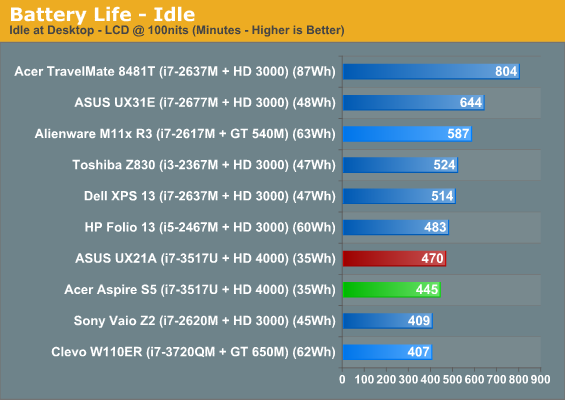
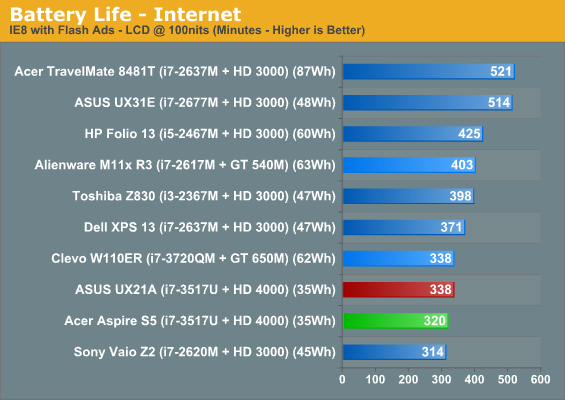
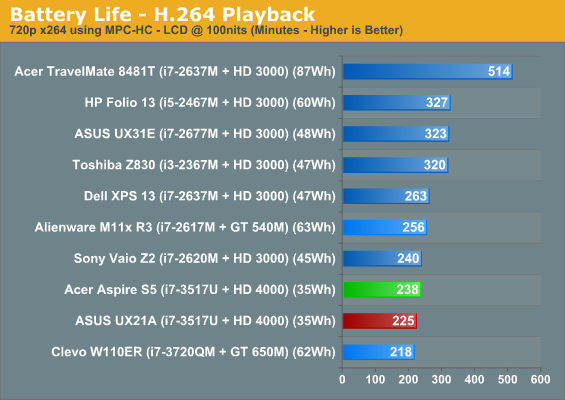
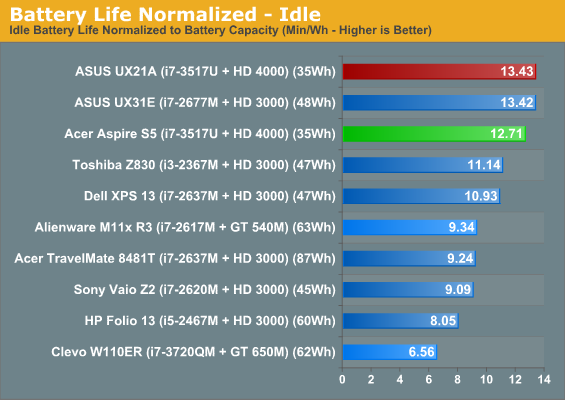

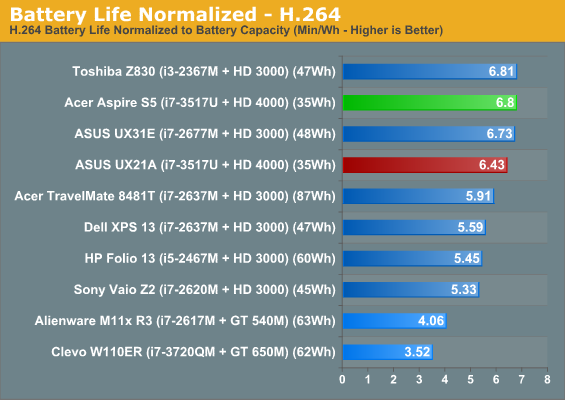
As it turns out, Acer's battery life estimate is mostly on the money and in fact can even be beaten in the right circumstances. Despite having a relatively small capacity, the Aspire S5 is still able to run for more than six useful hours. It's worth noting that overall, Ivy Bridge does seem to be able to produce better battery life efficiency as a whole than Sandy Bridge, and that's the kind of progress we can all appreciate.
Noise and Heat
Like most ultrabooks, the Acer Aspire S5 can get a bit noisy at load. What's important to note, though, is that at idle and low load, the fan is basically silent. The pitch of the fan noise is also relatively low; there's definitely the sound of air moving, but the noise is relatively tolerable compared to how high pitched these small fans can often get.

These thermals might look a little toasty, but they're actually among the best I've yet seen in an ultrabook. Acer has successfully implemented a remarkably efficient cooling system, and best of all, they've been able to do so without introducing any ventilation to the bottom of the notebook. Well done.
Screen Quality
Unfortunately, while the Aspire S5 is so far a pretty solid proposition from Acer, it falls flat on its face when it comes to display quality. The glossy finish on the S5 isn't as aggressive as I'm used to seeing, but that's about the nicest thing I can say about it. It's extremely disappointing that Acer isn't willing to bring the display up to par with the rest of the notebook.
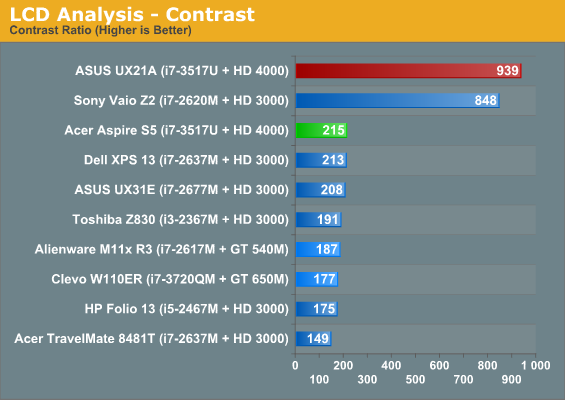


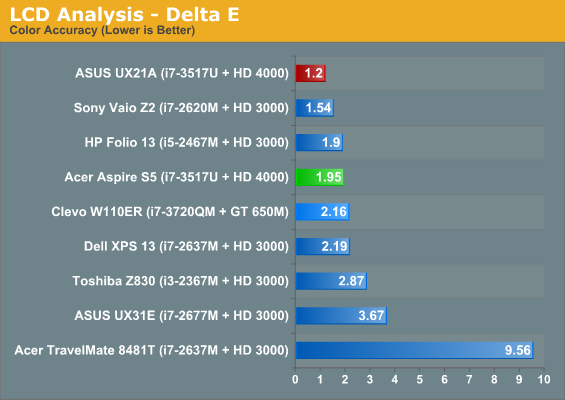
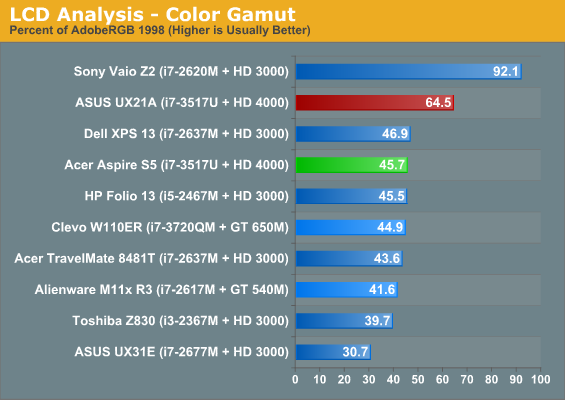

Display quality on most of these ultrabooks is just absolutely dire. If you look at the results of the ASUS Zenbook Prime UX21A, you can get a good idea of where the future lies, and it's not with shoddy panels like this one. Charging $1,399 for an ultrabook with this low quality of a panel is embarassing.










82 Comments
View All Comments
Death666Angel - Tuesday, July 10, 2012 - link
Perspective counts for much with this product. I think AT did well on the nuanced article and conclusion.Speed, thermals, noise, storage, keyboard, weight, battery capacity are all very well done with this notebook, above average for others of it's kind. Why should they call it overpriced piece of junk if there are people out there looking for these criteria in an ultrabook and not the display.
You and I may not be such people, they they do exist and thus these products warrant a thorough investigation of their good and bad traits. And reading this review, the bad traits are made as clear as the good.
kmmatney - Tuesday, July 10, 2012 - link
Seriously...You can get a refurbished MacBook Air for $929 with a much better 1440 x 900 display with full warrenty. It will be slower, but still probably fast enough with the same size SSD. Hell, you can buy a brand-new MacAir for cheaper. I don't know what Acer is thinking...it's got a great processor, but the price is still too high.
santeana - Tuesday, July 10, 2012 - link
Exactly. $1400 and it's about as upgradable as a friggin tablet. FAIL. Besides, aren't ultrabooks supposed to be below $1000 as part of their criteria for being an ultrabook? How are they supposed to achieve that if intel keeps charging so much for their cpu's? lolJaybus - Wednesday, July 11, 2012 - link
Nothing in this format is very upgradeable, and that includes the new MB Pro. There just isn't any space left inside to put anything. And that is exactly why they have Thunderbolt interfaces.xype - Tuesday, July 10, 2012 - link
…is that you get annoyed about it every time you use a laptop if it sucks. If there’s 2 instead of 3 USB ports, or USB 2.0 instead of USB 3.0 or an optical drive missing or even less RAM or HDD or lower-end CPU that’s all stuff that might bother you now and then at worst, more often than not actually never.But a bad display is what you look at all the time. That the manufacturers cut corners on that of all things is a complete mystery to me. It’s one of the things that can literally sell a laptop sitting poppep up on the shelves next to the competition, but nooo, put in a shitty display and then wonder why people hate your laptop.
randinspace - Tuesday, July 10, 2012 - link
It feels like a lot of reviews on Anandtech are summed up with "this is almost a great product." I'm not disagreeing with that sentiment, particularly with regards to Ultrabooks, but as a consumer it's frustrating that there are so few companies out there who are either pushing the envelope or doing so successfully.I mean, I would love to give Acer credit for having the "foresight" to include Thunderbolt since it could theoretically mitigate a lot of the weaknesses inherent to the notebook platform in general and Ultrabooks in particular, but in reality (it's probably the result of an extremely shortsighted deal they cut with Intel) there simply aren't any TB products out there yet which are compelling to me. More to the point the end result (an expensive notebook with dubious performance hooked up to an even more ridiculously expensive and dubiously effective external GPU + display solution) wouldn't make any more sense than other, slightly more traditional Acer laptops (like a better configured Aspire V3). *sigh
All that said I think the greatest potential for thunderbolt lies not in the consumer or even "enthusiast" space (mostly because enthusiasts have other recourse), but in highly specific and quite frankly impractical enterprise applications. Then again the days of "damn the costs we just need to get it done like THIS" probably ended 10 years ago...
BTW, nice review Dustin. Sorry I didn't really have anything on topic to say about it XD
IntelUser2000 - Tuesday, July 10, 2012 - link
I don't think the problem with Thunderbolt has to do with Intel. There's still technical hurdles to be something more widespread.Costs are still prohibitive, because it requires using chips with not an insignificant die size(30 to 50mm2+ depending on versions).
10Gbit/s is high for other I/Os, but still very low compared to PCI Express. You need 8 times the bandwidth to be of minimal loss: http://www.techpowerup.com/reviews/Intel/Ivy_Bridg...
In regards to Ultrabooks being almost there: I think they are getting there, but it would take some more time. Focus on PC manufacturers have been about lowering costs for most of the last decade.
Acer specific: It's quite obvious that they have 3 classes of the Ultrabook Aspire S series. The S3 is the low end, S5 the mid, and upcoming S7 the high end. It's easy to see the S5 is a big improvement over the S3, and the S7 is another step up from the S5.
JarredWalton - Tuesday, July 10, 2012 - link
Yeah, it *looks* (no promises until we see it!) like the S7 will use a touch-enabled IPS display. I'll keep my fingers crossed on that. As for the S3, as far as I can tell it's the same chassis as the original Aspire S3 Sandy Bridge Ultrabook, only now there's a model with the i7-3517U processor. Note that as far as I can tell, even with the Ivy Bridge CPU and HM77 chipset, there's still no USB 3.0 support. Ouch.IntelUser2000 - Tuesday, July 10, 2012 - link
I question Acer's decision on the Aspire S5. Like the MagicFlip port and the dual SSD setup. My biggest issue is the dual SSD setup.A single, high performance SSD would have been cheaper, with no negatives a RAID 0 setup brings.
RAID 0 negatives
-Two drives = more space
-Two controllers = higher cost and more power used
-Increased boot time for device recognition
It looks like the S7 has every reason to be popular against competition, not sure about the S5.
Pappnaas - Tuesday, July 10, 2012 - link
Honestly, if paying 1300 $ for a Laptop I won't put up with a 30$ display.As long as the display stays at 768p there's nothing premium about any Laptop bigger than 11.6".